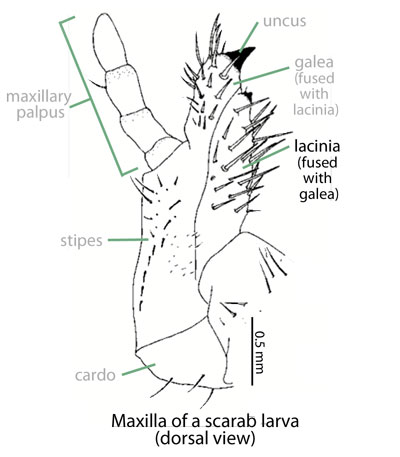Possibly Native
none known
Family: Scarabaeidae Subfamily: Melolonthinae Genus: Microserica Species: Microserica guamensis Gordon, 1971
none available
Total body length 4.2 mm (0.17 in). Body shape short, stout, broadly oval; widest posteriorly. Color reddish-brown. AntennaeAntennae:
paired sensory organ on head, formed from numerous segments
 11-segmented; club 4-segmented; club more than twice the length of segments 1–7. ElytraElytra:
11-segmented; club 4-segmented; club more than twice the length of segments 1–7. ElytraElytra:
the hardened and chitinous wing-cover of a beetle that protect and overlie the flight wing
weakly striated; lacking obvious setaesetae:
small, hair-like structure
. Females of this species are not known.
Undescribed. For Sericini (Ritcher, 1966Ritcher, 1966:
Ritcher P. 1966. White grubs and their allies: a study of North American scarabaeoid larvae. Oregon State University Monographs, Studies in Entomology 4: 1-219.): Grub C-shaped, not hump-backed, cylindrical, whitish. Cardocardo:
basal (first) segment of the maxilla , maxillary articulating membranemaxillary articulating membrane:
, maxillary articulating membranemaxillary articulating membrane:
membrane that covers the region where the maxillae articulates with the head
, and many other body parts with numerous black dots. Galeagalea:
outer branch or lobe of the maxilla
 and lacinialacinia:
and lacinialacinia:
inner portion of the maxilla fused proximally but separated distallydistally:
fused proximally but separated distallydistally:
situated away from the point of articulation, thus usually furthest from the body
or tightly fitted together. Last antennal segment always with a single, large, oblong, dorsaldorsal:
of or relating to the upper surface; opposite of ventral
, sensory spot. Haptomerumhaptomerum:
in larvae, the medio-anterior (middle of upper) portion of the epipharynx, composed of sensory spots
 with 3 or 4 heliheli:
with 3 or 4 heliheli:
in scarab larvae, a coarse spine on or near the haptomerum
. Dorsaldorsal:
of or relating to the upper surface; opposite of ventral
anal lobeanal lobe:
fleshy lobe surrounding anus on the last abdominal segment of larvae
much smaller than the ventralventral:
of or relating to the lower surface; opposite of dorsal
anal lobes. Anal lobes densely setosesetose:
covered in setae
. Rasterraster:
in scarab larvae, a complex of setose, spiny, and bare areas on the ventral surface of the last abdominal segment with a curved, transversetransverse:
with a curved, transversetransverse:
extending horizontally across a surface
row of prominent setaesetae:
small, hair-like structure
anterioranterior:
the front or forward; opposite of posterior
to the ventralventral:
of or relating to the lower surface; opposite of dorsal
anal lobes. Anal opening Y-shaped.
Uncertain. Although this scarab was described from Guam, Cartwright and Gordon (1971) suggested that it was not native. Instead, they proposed a potential Bornean origin for the species.
Undescribed. In many related Melolonthine genera, adults are generalist folivores and larvaelarvae:
the immature form of an insect; in scarabs, also called grub or white grub; preceded by the egg stage, followed by the pupal stage
 feed upon plant roots (Ratcliffe and Paulsen, 2008Ratcliffe and Paulsen, 2008:
feed upon plant roots (Ratcliffe and Paulsen, 2008Ratcliffe and Paulsen, 2008:
Ratcliffe B and Paulsen P. 2008. The scarabaeoid beetles of Nebraska (Coleoptera: Scarabaeoidea). Bulletin of the University of Nebraska 22: 138-248.).
Poorly known. Cartwright and Gordon (1971) noted that this species does not come to lights, thus suggesting a diurnaldiurnal:
active during daylight hours
habit. It is likely that adults are folivores and that the larvaelarvae:
the immature form of an insect; in scarabs, also called grub or white grub; preceded by the egg stage, followed by the pupal stage
 develop within soil where they feed on plant roots. Such habits are seen in related genera including Serica (Ratcliffe and Paulsen, 2008Ratcliffe and Paulsen, 2008:
develop within soil where they feed on plant roots. Such habits are seen in related genera including Serica (Ratcliffe and Paulsen, 2008Ratcliffe and Paulsen, 2008:
Ratcliffe B and Paulsen P. 2008. The scarabaeoid beetles of Nebraska (Coleoptera: Scarabaeoidea). Bulletin of the University of Nebraska 22: 138-248.) and Maladera (Skelley, 2013Skelley, 2013:
Skelley P. 2013. Asiatic garden beetle, Maladera castanea . University of Florida, Featured Creatures. Available from http://entnemdept.ufl.edu/creatures/ORN/TURF/asiatic_garden_beetle.htm (accessed 2015).).
Probably none. There are no records of this poorly known species acting as a plant pest.
Not established or recorded. There are no records of this scarab from Hawaii.
Recorded, not established. This scarab was described from Guam (Cartwright and Gordon, 1971Cartwright and Gordon, 1971:
Cartwright O and Gordon R. 1971. Insects of Micronesia Coleoptera: Scarabaeidae. Insects of Micronesia 17: 256-296.) and is included on the Bourquin, 2002Bourquin, 2002:
Bourquin O. 2002. Invertebrates recorded from the Northern Mariana Islands status 2002. CNMI Invertebrate Collection Crees-Northern Marianas College, Saipan. checklist. However, it appears that the species is known only from the type specimen, and no further specimens have been taken on Guam. This suggests the species is not established.
If this species was introduced to Guam, it is likely that it arrived to the island by hitchhiking on marine or air cargo. Potentially, adults also could have arrived on incoming nursery plants, and larvaelarvae:
the immature form of an insect; in scarabs, also called grub or white grub; preceded by the egg stage, followed by the pupal stage
 or eggs could have been transported in soil or sod.
or eggs could have been transported in soil or sod.
This species is somewhat similar to the Maladera species recorded from Hawaii. Microserica guamensis can be separated from the Maladera species based on its much smaller size (3.7–4.7 mm [0.15–0.19 in] in M. guamensis versus 7.0–10.0 mm [0.28–0.39 in] in Maladera) and the form of its antennaeantennae:
paired sensory organ on head, formed from numerous segments
 (11-segmented antennaeantennae:
(11-segmented antennaeantennae:
paired sensory organ on head, formed from numerous segments
 with 4-segmented club in M. guamensis versus 10-segmented antennaeantennae:
with 4-segmented club in M. guamensis versus 10-segmented antennaeantennae:
paired sensory organ on head, formed from numerous segments
 with 3-segment club in Maladera).
with 3-segment club in Maladera).
none known
Report your observation of this rare and possibly native Guamanian species at our iNaturalist project.